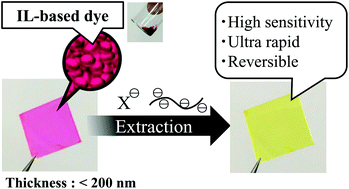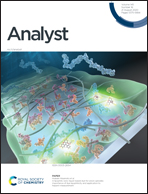A lipophilic ionic liquid-based dye for anion optodes: importance of dye lipophilicity and application to heparin measurement†
Abstract
Herein, a fully lipophilic ionic liquid (IL) comprising a lipophilic fluorescein anion and a trihexyltetradecylphosphonium cation was synthesized and used as the plasticizer for a plasticized poly(vinyl chloride) (PVC) membrane optode. Systematic investigation of the alkyl chain length of the fluorescein anion proved the significance of lipophilicity for obtaining the reversible absorbance measurements. A PVC membrane fabricated with the synthesized lipophilic IL was observed to comprise an unusually high dye concentration (915 mmol kg−1) and exhibited good sensitivity as well as response time in its sensor performance. The sensitivity of the presented PVC membrane was 26-fold higher than that of a conventional optode membrane with the same membrane thickness and the same lipophilic dye of typical dye content (1 wt%). The response time was observed to be >120-fold faster by using a significantly thinner PVC membrane (approx. 140 nm). Heparin is known to be a polyanionic anticoagulant, and the presented PVC membrane exhibited an extremely fast response (20–150 seconds) to the heparin in diluted serum within the required concentration region. Thus, the lipophilic IL-based dye could significantly improve the sensor performance in conventional optodes, especially for an analyte showing slow diffusion, such as macromolecular heparin.



 Please wait while we load your content...
Please wait while we load your content...